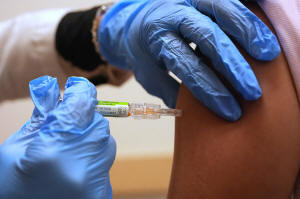Some flu measures decline, but it's not clear this severe season has
peaked
[January 10, 2026]
By MIKE STOBBE
NEW YORK (AP) — U.S. flu infections showed signs of a slight decline
last week, but health officials say it is not clear that this severe flu
season has peaked.
New government data posted Friday — for flu activity through last week —
showed declines in medical office visits due to flu-like illness and in
the number of states reporting high flu activity.
However, some measures show this season is already surpassing the flu
epidemic of last winter, one of the harshest in recent history. And
experts believe there is more suffering ahead.
“This is going to be a long, hard flu season,” New York State Health
Commissioner Dr. James McDonald said, in a statement Friday.
One type of flu virus, called A H3N2, historically has caused the most
hospitalizations and deaths in older people. So far this season, that is
the type most frequently reported. Even more concerning, more than 91%
of the H3N2 infections analyzed were a new version — known as the
subclade K variant — that differs from the strain in this year’s flu
shots.
The last flu season saw the highest overall flu hospitalization rate
since the H1N1 flu pandemic 15 years ago. And child flu deaths reached
289, the worst recorded for any U.S. flu season this century — including
that H1N1 “swine flu” pandemic of 2009-2010.

So far this season, there have been at least 15 million flu illnesses
and 180,000 hospitalizations, the U.S. Centers for Disease Control and
Prevention estimates. It also estimates there have been 7,400 deaths,
including the deaths of at least 17 children.
Last week, 44 states reported high flu activity, down slightly from the
week before. However, flu deaths and hospitalizations rose.
Determining exactly how flu season is going can be particularly tricky
around the holidays. Schools are closed, and many people are traveling.
Some people may be less likely to see a doctor, deciding to just suffer
at home. Others may be more likely to go.
[to top of second column]
|

Pharmacy manager Aylen Amestoy administers a patient with a seasonal
flu vaccine at a CVS Pharmacy in Miami, Tuesday, Sept. 9, 2025. (AP
Photo/Rebecca Blackwell, File)
 Also, some seasons see a surge in
cases, then a decline, and then a second surge.
For years, federal health officials joined doctors' groups in
recommending that everyone 6 months and older get an annual
influenza vaccine. The shots may not prevent all symptoms but can
prevent many infections from becoming severe, experts say.
But federal health officials on Monday announced they will no longer
recommend flu vaccinations for U.S. children, saying it is a
decision parents and patients should make in consultation with their
doctors.
“I can’t begin to express how concerned we are about the future
health of the children in this country, who already have been
unnecessarily dying from the flu — a vaccine preventable disease,”
said Michele Slafkosky, executive director of an advocacy
organization called Families Fighting Flu.
“Now, with added confusion for parents and health care providers
about childhood vaccines, I fear that flu seasons to come could be
even more deadly for our youngest and most vulnerable," she said in
a statement.
Flu is just one of a group of viruses that tend to strike more often
in the winter. Hospitalizations from COVID-19 and RSV, or
respiratory syncytial virus, also have been rising in recent weeks —
though were not diagnosed nearly as often as flu infections,
according to other federal data.
All contents © copyright 2026 Associated Press. All rights reserved
 |